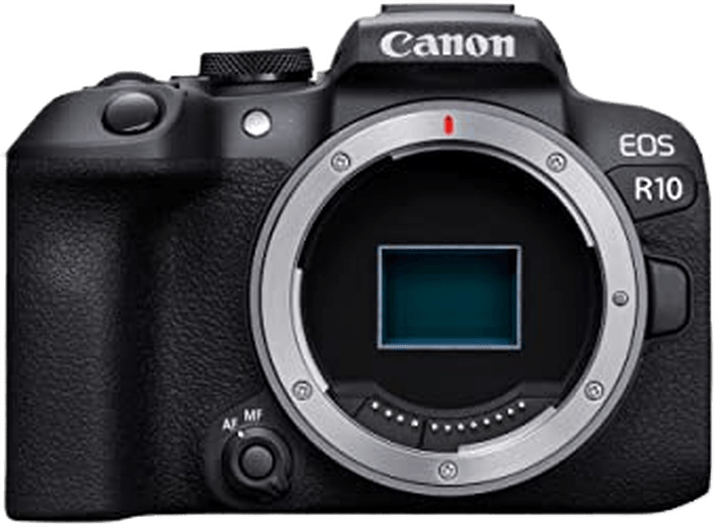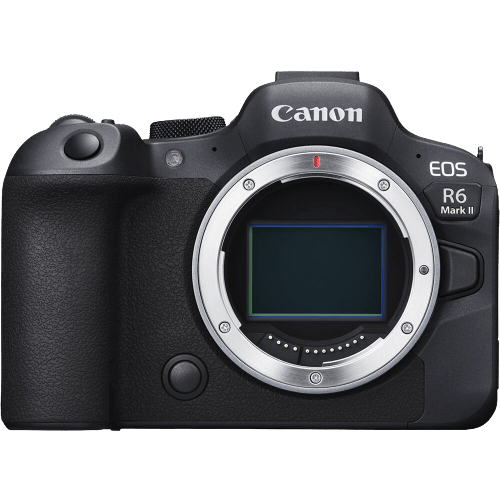Canon EOS R10 vs EOS R6 Mark II Comparison
Canon EOS R10

Canon EOS R6 Mark II

The Canon EOS R6 Mark II takes the lead with a score of 78/100, while the Canon EOS R10 trails behind with a 69/100. Both cameras are mirrorless and were released in 2022, sharing similarities in their design and features. However, there are distinct differences that set them apart.
The Canon EOS R6 Mark II outshines the R10 in terms of performance, justifying its higher score. Despite being larger and heavier, measuring 138.4 x 98.4 x 88.4mm and weighing 588g, the R6 Mark II’s higher launch price of $2499 reflects its superior capabilities and features.
On the other hand, the Canon EOS R10 is a more budget-friendly option, with a launch price of $980. It is also more compact and lightweight, measuring 123 x 88 x 83mm and weighing 426g, which may appeal to those seeking a more portable camera.
Taking everything into account, the Canon EOS R6 Mark II is the better camera in terms of performance and features. However, the Canon EOS R10 offers a more affordable and portable alternative for those who prioritize budget and portability.
Canon EOS R10 vs EOS R6 Mark II Overview and Optics
The Canon EOS R6 Mark II outperforms the Canon EOS R10 in optics, scoring 83/100 compared to the R10’s 71/100. Both cameras share several key specifications, including 24 megapixels, a CMOS sensor, Digic X processor, and Canon RF lens mount. However, the R6 Mark II has some significant advantages over the R10, which contribute to its higher score.
One of the main differences between the two cameras is the sensor size. The R6 Mark II has a full-frame sensor, while the R10 has an APS-C sensor. A full-frame sensor provides better image quality, especially in low light conditions, and a wider field of view. Additionally, the R6 Mark II has image stabilization, which the R10 lacks. This feature helps to reduce camera shake and produce sharper images, particularly in situations where handholding is necessary.
Although the R10 has a higher DXOMARK score for its sensor (97 compared to the R6 Mark II’s 91), this advantage does not outweigh the benefits of the R6 Mark II’s full-frame sensor and image stabilization. The R10 does, however, have a faster shooting speed of 15, compared to the R6 Mark II’s 40. This may be beneficial for photographers who prioritize capturing fast-moving subjects.
Despite the R10’s faster shooting speed, the Canon EOS R6 Mark II’s full-frame sensor and image stabilization make it a superior choice for those seeking optimal optical performance. The R10 may still be a suitable option for photographers who prioritize speed, but the R6 Mark II is the clear winner in terms of overall optics.
Canon EOS R10 vs EOS R6 Mark II Video Performance
The Canon EOS R10 outperforms the Canon EOS R6 Mark II in video capabilities with a score of 91/100, compared to the R6 Mark II’s score of 83/100. Both cameras share some common specifications, such as 4K max video resolution and 3840 x 2160 max video dimensions. Additionally, both cameras have built-in time-lapse functionality, making them suitable for creative videography projects.
The Canon EOS R10 excels in video performance due to its higher max video frame rate of 120fps, compared to the R6 Mark II’s 60fps. This feature allows the R10 to capture smoother, more detailed slow-motion footage, making it ideal for action-oriented videography or capturing fast-moving subjects. This significant advantage in frame rate contributes to the R10’s higher video score.
While the Canon EOS R6 Mark II has a lower video score, it still offers impressive video capabilities with its 4K resolution and 60fps max video frame rate. Although its frame rate is lower than the R10’s, it is still sufficient for most videography needs and can produce high-quality footage. The R6 Mark II’s video performance should not be dismissed, as it remains a strong contender in the market.
Comparing the video capabilities of the Canon EOS R10 and R6 Mark II, the R10 emerges as the superior choice due to its higher video score and max frame rate. However, the R6 Mark II remains a reliable option for those seeking high-quality 4K video with a lower budget or less demanding frame rate requirements.
Canon EOS R10 vs EOS R6 Mark II Features and Benefits
The Canon EOS R6 Mark II wins the features comparison with a score of 72/100, while the Canon EOS R10 scores 70/100. Both cameras share several specifications, including a 3-inch touchscreen, flip screen, WIFI, and Bluetooth capabilities.
The EOS R6 Mark II outperforms the EOS R10 in screen resolution and GPS functionality. The higher screen resolution of 1,620,000 dots allows for clearer and more detailed image previews. Additionally, the built-in GPS feature in the EOS R6 Mark II enables users to geotag their images, a function not available in the EOS R10.
Despite its lower feature score, the EOS R10 still has some advantages. Both cameras have the same screen size and possess a touchscreen and flip screen. These similarities provide users with comparable ease of use and flexibility when composing their shots. However, the R10’s lower score does not offer any distinct advantages over the R6 Mark II.
Considering the specifications of both cameras, the Canon EOS R6 Mark II is the better choice for those who prioritize higher screen resolution and GPS functionality. On the other hand, the Canon EOS R10 provides a similar user experience in terms of screen size, touchscreen, and flip screen, but lacks the additional features found in the EOS R6 Mark II. Based on these points, the EOS R6 Mark II is the superior camera in terms of features.
Canon EOS R10 vs EOS R6 Mark II Storage and Battery
The Canon EOS R6 Mark II wins in storage and battery with a score of 68/100, while the Canon EOS R10 scores 40/100. Both cameras share the feature of USB charging and accept SD, SDHC, and SDXC memory cards. However, the R6 Mark II surpasses the R10 in two key aspects.
The R6 Mark II has two memory card slots, allowing for greater storage capacity and flexibility, while the R10 only has one. Additionally, the R6 Mark II is compatible with faster UHS-II memory cards, ensuring quicker file transfers and overall improved performance.
In terms of battery life, the R10 outperforms the R6 Mark II with 450 shots per charge compared to the R6 Mark II’s 360 shots. Although the R10 has a longer battery life, the R6 Mark II’s superior storage capabilities make it the better choice for those prioritizing memory capacity and speed.
Canon EOS R10 vs EOS R6 Mark II – Our Verdict
Are you still undecided about which camera is right for you? Have a look at these popular comparisons that feature the Canon EOS R10 or the Canon EOS R6 Mark II:

